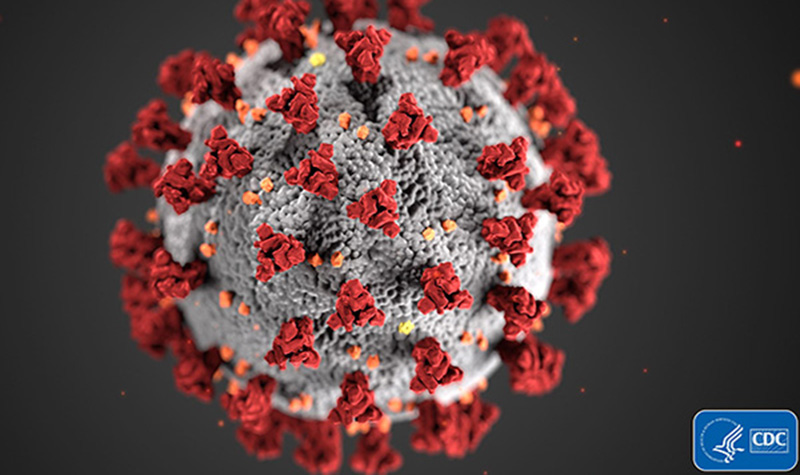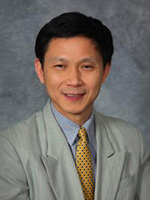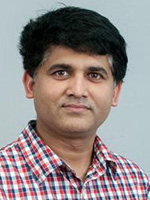Racing against the next pandemic
UND researchers direct focus to COVID-19, make case for expanded infectious disease research space

Anxious, but not surprised.
That’s how infectious disease researchers at the UND School of Medicine & Health Sciences (SMHS) tend to characterize their response to the emergence of SARS-CoV-2, the source of COVID-19.
“[The influenza outbreak of 1918] infected one-third of the world, and killed around 50 million people, including 1 million in the U.S.” said Nadeem Khan, assistant professor in the Department of Biomedical Sciences at the SMHS. “After that, every decade or two, you see the emergence of some pandemic flu or SARS or Ebola. These viruses emerge, they become lethal, they disseminate, they transmit. It doesn’t happen every year, but it is likely every decade or two.”
And because such pandemics seem to be getting more regular, said Khan, he and his Department of Biomedical Sciences colleagues Min Wu and Masfique Mehedi are moving as fast as they can to study not only coronavirus vaccines, but pandemic prevention, preparedness, and treatment.

Figuring it out
Each of these researchers were diving head-first into a pandemic that, at the time of this writing, was only about a month old in the U.S.
A National Institutes of Health-funded influenza researcher, Khan shifted his attention quickly to COVID-19 in March.
“There are two lines of investigation going on now with coronavirus,” Khan told North Dakota Medicine via video conference. “The first is developing an effective vaccine, which is able to control infection. The other is understanding how COVID-19 causes disease. Once you understand how the virus causes disease in the respiratory tract, then you’re able to selectively intervene in the disease process and stop the disease. We are interested in both aspects: understanding the disease pathogenesis as well as developing a novel vaccine against COVID-19. We will attempt to understand how COVID-19 is initiating the disease process in the lungs and how this is leading to developing a fatal pneumonia.”
As Khan put it, although COVID-19 is a novel virus, which emerged just last year, it is related not only to influenza but another coronavirus—SARS—that hit the world hard in 2003.
Therefore, coronavirus, whose genome was sequenced in China months ago, is less mysterious than it might seem to non-scientists. COVID-19 seems to be structured like the flu, for example. It is also transmitted and acquired in a similar way and produces similar symptoms.
This is all good news, said Khan, who sees similar proteins in each of the viruses in question.
“To develop an efficacious vaccine against COVID could take up to a year and a half,” Khan shrugged. “By that time, you may not even see this virus present in the environment. So, you might get a vaccine that then is non-efficacious. That’s not to say vaccines are not important—of course they’re important. But you will need vaccines which are robustly cross-protective should the virus re-emerge in human circulation in modified form. Therefore, the race to vaccine must consider producing antibodies of better functionalities that can cross-protect against new form of virus.”
This is why Khan is looking to inhibit whatever it is that elicits the human immune response to the infection and determine treatment options that help revert COVID-19 to more of a flu-like convalescence.
“Our goal is to make COVID-19 a less severe infection that transmits less easily and quickly.”
A Marshall Plan for infection
Parting of making this happen, added Dr. Wu, hinges on all nations’ ability to cooperate and coordinate research and response efforts, even before the next virus strikes.
That vision of preparation and coordination has been his focus since March. This past spring, the researcher specializing in respiratory disease submitted a “Notice of Special Interest” proposal to the NIH’s National Institute of Allergy and Infectious Diseases. Titled “Sustained research fund and dedicated research center for preparing next pandemic,” the short paper is geared not simply to the study COVID-19 pathology but calls for an international infrastructure designed to prevent—or respond to more effectively—the next novel virus.

“I expect that this type of pandemic will come back, probably sooner and more often,” said Wu, whose paper calls for nothing less than a global Marshall Plan for infectious disease prevention, research, and response.
“A large scale infrastructure, resource, and task force program is desperately needed at state, national, and even international levels to build many dedicated research centers to develop diagnostics, vaccines, and drugs, as well as basic research to understand the molecular and cellular pathogenesis and host-pathogen interactions,” wrote Wu and his colleague Dr. Hongpeng Jia, M.D., assistant professor of surgery at Johns Hopkins University School of Medicine. “We call for governments, the World Health Organization, and the United Nations to rethink this need as a concerted effort to maximally prevent and curb future pandemics. We need not only research dollars but also infrastructure, hospitals, containments, and medical disposables.”
UND is an obvious choice to coordinate such efforts locally, said Wu, given that the SMHS houses a strong team of researchers working in an NIH Centers of Biomedical Research Excellence (CoBRE) core dedicated to infectious disease. To that end, Wu has explored the possibility of housing a higher-level facility in Grand Forks to study COVID-19 and other emerging pandemics.
“The critical lesson we’ve learned from past experiences and the new pandemic is that we cannot continue to do the same as we have done before,” said Wu. “Instead, we genuinely need an urgent and fundamental change. UND can and should be part of that effort.”

Biosafety Level-up
Such a scaled-up laboratory in the region would benefit research at UND generally — possibly expediting the Centers for Disease Control & Prevention certification process above and beyond UND’s current Biosafety Level 2 lab.
“We don’t have an active BSL3 lab at UND,” noted Khan. “This is the minimum requirement of labs to be able to handle coronavirus. We cannot do anything with the live virus. Instead we use those dead components of the virus in conjunction with human cells to see how they interact.”

Khan’s colleague Masfique Mehedi concurred.
“I can’t do COVID-19 infectious virus research here,” said the researcher specializing in respiratory syncytial virus (RSV). “However, I have a collaboration with colleagues at the Rocky Mountain Laboratories in Montana. I am planning to do a couple of experiments through them, comparing SARS, MERS and COVID-19 infection studies in human respiratory airway models developed from [chronic obstructive pulmonary disease] patients.”
For his part, Mehedi echoes Khan in suggesting that it would be much easier for area researchers to have more specialized facilities in-house rather than having to work with labs at times thousands of miles away. There are no active BSL3 or BSL4 facilities anywhere in the upper Midwest.
Wu’s view is that whatever the level of such a facility, a stronger, more coordinated research infrastructure is clearly needed globally to combat any number of pathogens and infectious disease processes—and it is in the world’s interest to invest more heavily in such science.
“Fortunately, we have leadership at UND who is creatively outsourcing to seek the possibility to establish a laboratory on campus that could improve our infrastructure to support COVID-19 research,” Wu concluded. “To improve our state’s health and well-being, and to hasten diagnosis, prevention, and treatment, we are working on all fronts to find new mechanisms and develop new vaccines or treatments or this and other horrible diseases.”
About the author
 Brian James Schill is the assistant director of the Office of Alumni and Community Relations at the University of North Dakota School of Medicine & Health Sciences.
Brian James Schill is the assistant director of the Office of Alumni and Community Relations at the University of North Dakota School of Medicine & Health Sciences.


